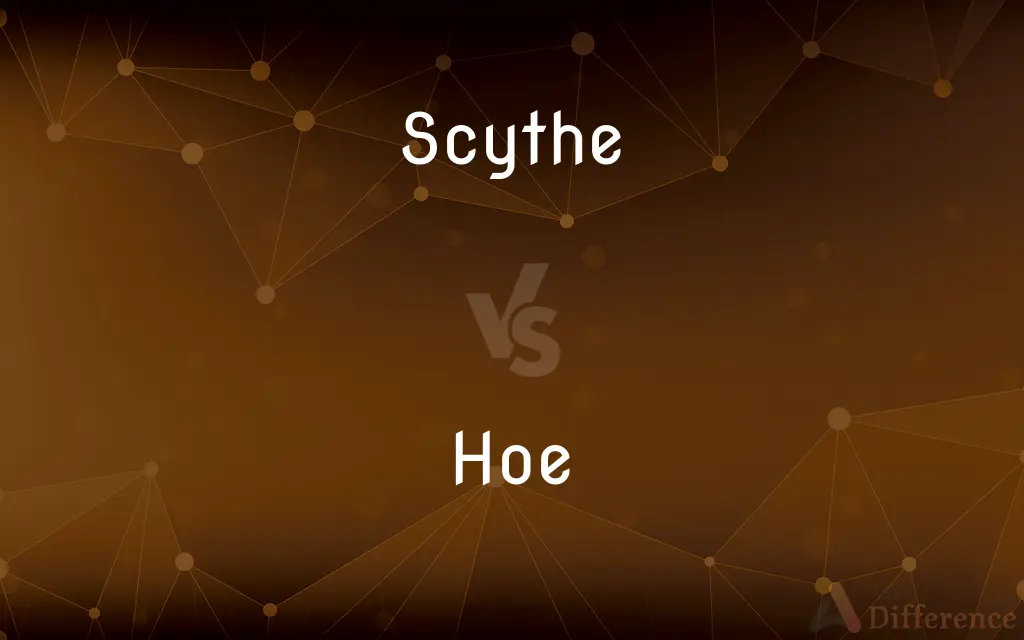Scythe vs. Hoe — What's the Difference?
By Urooj Arif & Fiza Rafique — Updated on March 31, 2024
A scythe is a long-handled agricultural tool with a curved blade for cutting grass or grain, while a hoe is a tool used for breaking up the soil and removing weeds.

Difference Between Scythe and Hoe
Table of Contents
ADVERTISEMENT
Key Differences
A scythe, characterized by its long handle and curved blade, is primarily used for cutting grass, grain, or other crops close to the ground. It is swung in a wide arc by the user, allowing for efficient cutting over large areas. On the other hand, a hoe, with its shorter handle and flat blade set at a right angle, is designed for cultivating soil, breaking up lumps, and removing weeds around plants.
The scythe is most effective in open fields where large swaths of crops or grass need to be cut quickly and efficiently. Its design facilitates a horizontal swinging motion, cutting through vegetation with each pass. Hoes, whereas, are better suited for smaller garden or farm plots where precise soil manipulation and weed control are necessary. The vertical chopping motion of a hoe allows for targeted action in the soil close to plants, minimizing damage to the crops.
Ergonomically, the use of a scythe requires a standing position with a series of sweeping motions that engage the whole body, making it suitable for cutting at ground level without the need for bending. This contrasts with the hoe, which often requires the user to bend over or kneel, using more localized arm and back movements to dig or chop at the soil, potentially leading to more strain over long periods.
From a maintenance perspective, both tools require care to ensure longevity and effectiveness. A scythe blade must be regularly sharpened and properly adjusted to maintain its cutting efficiency, especially given its broad swath of action. Hoes, on the other hand, require less frequent sharpening, but their blade's angle and attachment to the handle must be checked regularly to withstand the impact of chopping and digging.
The historical significance of each tool reflects their development and use in agriculture. The scythe has been a symbol of agricultural bounty and labor efficiency, especially before the advent of mechanized farming tools. The hoe, one of the oldest agricultural tools, symbolizes the ongoing human effort in cultivation, soil management, and the direct relationship between humans and the earth.
ADVERTISEMENT
Comparison Chart
Primary Use
Cutting grass or grain close to the ground.
Breaking up soil, cultivating, and removing weeds.
Design
Long handle with a curved blade for swinging motion.
Shorter handle with a flat blade set at a right angle for chopping.
Efficiency
High efficiency in cutting large areas quickly.
Efficient for targeted soil manipulation and weed control in smaller areas.
Ergonomics
Requires standing position, engages whole body.
Often requires bending or kneeling, uses arm and back movements.
Maintenance
Requires regular sharpening and adjustment.
Requires less frequent sharpening, but needs checks for blade angle and attachment.
Historical Significance
Symbol of agricultural bounty and labor efficiency.
Represents the human effort in cultivation and soil management.
Compare with Definitions
Scythe
A tool with a long handle and a curved blade for cutting crops.
The farmer used a scythe to cut down the wheat.
Hoe
Requires physical effort, particularly in the back and arms.
After a day of hoeing, his back was sore.
Scythe
Needs regular care to maintain its edge.
Sharpening the scythe’s blade is an important task after each use.
Hoe
A gardening tool for soil cultivation and weed removal.
She used a hoe to prepare the garden bed for planting.
Scythe
Requires skill and strength to use effectively.
Mastering the scythe took the young farmhand weeks of practice.
Hoe
Designed for precise work around plants.
With a hoe, gardeners can remove weeds without harming their crops.
Scythe
Symbolic of agricultural labor.
The scythe stands as a symbol of the hard work of past agricultural societies.
Hoe
Part of the basic toolkit for gardeners and farmers.
Every gardener relies on a hoe for keeping their plot weed-free.
Scythe
Used for efficient harvesting of large fields.
Before machines, scythes were essential for harvesting crops.
Hoe
Essential for maintaining healthy garden soil.
Regular hoeing helps aerate the soil, promoting plant growth.
Scythe
A scythe is an agricultural hand tool for mowing grass or harvesting crops. It is traditionally used to cut down or reap edible grains, before the process of threshing.
Hoe
A tool with a flat blade attached approximately at a right angle to a long handle, used for weeding, cultivating, and gardening.
Scythe
A tool used for cutting crops such as grass or corn, with a long curved blade at the end of a long pole attached to one or two short handles.
Hoe
To weed, cultivate, or dig up with a hoe.
Scythe
Cut with a scythe
The grass was scythed at regular intervals
You may want hardy infantry troops to scythe down the opposition
The first job was to scythe paths through the nettles
Hoe
To work with a hoe.
Scythe
An implement consisting of a long, curved single-edged blade with a long handle, used for mowing or reaping.
Hoe
Alternative spelling of ho.
Scythe
To cut with or as if with a scythe.
Hoe
An agricultural tool consisting of a long handle with a flat blade fixed perpendicular to it at the end, used for digging rows.
Scythe
An instrument for mowing grass, grain, etc. by hand, composed of a long, curving blade with a sharp concave edge, fastened to a long handle called a snath.
Hoe
A piece of land that juts out towards the sea; a promontory.
Scythe
(historical) A scythe-shaped blade attached to ancient war chariots.
Hoe
(ambitransitive) To cut, dig, scrape, turn, arrange, or clean, with this tool.
To hoe the earth in a garden
Every year, I hoe my garden for aeration.
I always take a shower after I hoe in my garden.
Scythe
(cartomancy) The tenth Lenormand card.
Hoe
(transitive) To clear from weeds, or to loosen or arrange the earth about, with a hoe.
To hoe corn
Scythe
(intransitive) To use a scythe.
Hoe
Alternative spelling of ho.
Scythe
(transitive) To cut with a scythe.
Hoe
A tool chiefly for digging up weeds, and arranging the earth about plants in fields and gardens. It is made of a flat blade of iron or steel having an eye or tang by which it is attached to a wooden handle at an acute angle.
Scythe
(transitive) To cut off as with a scythe; to mow.
Hoe
The horned or piked dogfish. See Dogfish.
Scythe
To attack or injure as if cutting.
Hoe
To cut, dig, scrape, turn, arrange, or clean, with a hoe; as, to hoe the earth in a garden; also, to clear from weeds, or to loosen or arrange the earth about, with a hoe; as, to hoe corn.
Scythe
An instrument for mowing grass, grain, or the like, by hand, composed of a long, curving blade, with a sharp edge, made fast to a long handle, called a snath, which is bent into a form convenient for use.
The sharp-edged scythe shears up the spiring grass.
Whatever thingThe scythe of Time mows down.
Hoe
To use a hoe; to labor with a hoe.
Scythe
A scythe-shaped blade attached to ancient war chariots.
Hoe
A tool with a flat blade attached at right angles to a long handle
Scythe
To cut with a scythe; to cut off as with a scythe; to mow.
Time had not scythed all that youth begun.
Hoe
Dig with a hoe;
He is hoeing the flower beds
Scythe
An edge tool for cutting grass; has a long handle that must be held with both hands and a curved blade that moves parallel to the ground
Scythe
Cut with a scythe;
Scythe grass or grain
Common Curiosities
What is a hoe used for?
A hoe is used for breaking up soil, cultivating, and removing weeds in smaller plots.
Can a scythe be used for weeding?
While a scythe is mainly for cutting vegetation at ground level, it's not suited for targeted weeding like a hoe.
Do both tools require a lot of maintenance?
Both require maintenance, but a scythe needs more regular sharpening due to its extensive cutting action.
What skills are needed to use a scythe effectively?
Skill and strength are required to use a scythe effectively, including proper swinging technique and blade maintenance.
Are scythes and hoes still used today?
Yes, both are used, especially in sustainable and small-scale farming, as well as in gardens.
Can using these tools be physically demanding?
Yes, both tools can be physically demanding, though the scythe engages the whole body, while the hoe is more taxing on the back and arms.
How does the design of these tools affect their use?
The design of each tool is tailored to its specific use: scythes for broad cutting and hoes for precise soil and weed management.
Is a hoe effective for large scale farming?
Hoes are more effective for precise tasks in smaller areas rather than large-scale farming.
What is a scythe used for?
A scythe is used for cutting grass, grain, or crops close to the ground over large areas.
Which tool is older, the scythe or the hoe?
The hoe is one of the oldest agricultural tools, predating the scythe, which evolved for more efficient harvesting.
Can the blade of a hoe be sharpened?
Yes, hoe blades can be sharpened to maintain effectiveness in cutting through soil and roots.
What ergonomic considerations should be taken when using these tools?
Proper posture and technique are important to minimize strain and maximize efficiency with both tools.
Are there modern versions of these tools?
Yes, modern versions exist, including ergonomic designs and materials to improve efficiency and reduce physical strain.
How does the use of a hoe benefit plants?
Hoeing aerates the soil and removes weeds, which competes with plants for nutrients and water, thereby benefiting plant growth.
What are the safety concerns when using a scythe?
Safety concerns include proper handling to avoid injury from the sharp blade and ensuring the area is clear of obstacles.
Share Your Discovery

Previous Comparison
Stator vs. Alternator
Next Comparison
Bushing vs. WasherAuthor Spotlight
Written by
Urooj ArifUrooj is a skilled content writer at Ask Difference, known for her exceptional ability to simplify complex topics into engaging and informative content. With a passion for research and a flair for clear, concise writing, she consistently delivers articles that resonate with our diverse audience.
Co-written by
Fiza RafiqueFiza Rafique is a skilled content writer at AskDifference.com, where she meticulously refines and enhances written pieces. Drawing from her vast editorial expertise, Fiza ensures clarity, accuracy, and precision in every article. Passionate about language, she continually seeks to elevate the quality of content for readers worldwide.














































